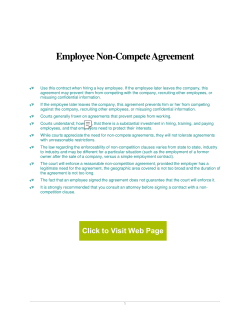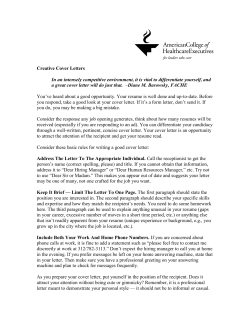
BUSINESS PLAN NON-DISCLOSURE AGREEMENT & GUIDE Included:
BUSINESS PLAN NON-DISCLOSURE AGREEMENT & GUIDE Included: Overview Dos and Don’ts Checklist Business Plan Non-Disclosure Agreement Instructions Sample Business Plan Non-Disclosure Agreement © LEGALZOOM.COM, INC. 2008 1. Overview Non-disclosure agreements (also called NDAs or confidentiality agreements) have become increasingly important for businesses of all sizes, serving as the first line of defense in protecting company inventions, trade secrets, and hard work. These agreements are critical not only when confidential information has been wrongly disclosed, but also when such disclosures have not yet occurred. At their core, non-disclosure agreements build relationships of trust between two or more parties. The agreements contemplate situations in which at least one party is sharing confidential and proprietary information with the other, and protect the immediate and future security of the disclosed information. Once signed, a non-disclosure agreement allows for open dialogue between parties, creating an environment in which information can be discussed freely and the true objectives of the meeting or relationship can be achieved (e.g., a company can be created, a strategic partnership can be established, etc.). The enclosed document allows your company to reveal its business plans without worrying that a consultant will turn into a competitor. A written contract minimizes confusion, misunderstanding, and error, and sets forth the parties’ expectations and fulfillment obligations. In every way, this promotes successful and profitable business arrangements. 2. Dos & Don’ts Checklist Creating a non-disclosure agreement is the first of many steps in maintaining and protecting your organization’s business plan and other confidential information. The following tips will provide additional guidance about protecting your company: Protecting proprietary information should be the rule and not the exception. Get in the habit of using a non-disclosure agreement any time there is a possibility sensitive information will be disclosed. Instruct all company employees and associates about the importance, security, and protection of confidential information. Wrongful disclosure can happen at any level of your organization. Many business owners hesitate to use non-disclosure agreements, fearing they imply suspicion of or doubt about the other party. This is a mistake. Non-disclosure agreements are common in modern business, and most people won’t blink if asked to sign one. If someone does object, ask yourself if you truly want to be in business with that person. Make at least two copies of the signed agreement, one for you and the remainder for the other parties to the agreement. Keep the signed non-disclosure agreement in a safe place. An executed agreement is useless if it can’t be found. Don’t rely on oral promises of confidentiality. They are hard to prove and are harder to enforce. BUSINESS PLAN NON-DISCLOSURE AGREEMENT © LEGALZOOM.COM, INC. 2008 1 In addition to using a non-disclosure agreement, write “CONFIDENTIAL” in bold letters on your business plan and any other documents with proprietary information. This will remind everyone of the nature of the information and of their obligation to protect it. Review the non-disclosure agreement carefully. One size does not fit all. 3. Business Plan Non-Disclosure Agreement Instructions The following provision-by-provision instructions will help you understand the terms of your business plan non-disclosure agreement. The numbers and letters below (e.g., Section 1, Section 2(c), etc.) correspond to provisions in the contract. Please review the entire agreement before starting your step-by-step process. • Introduction of Parties. Identifies the document as a business plan non-disclosure agreement. Write in the date on which the agreement will become effective (often the date on which it is signed). Identify the parties and, if applicable, what type of organization(s) they are. Note that each party is given a name (e.g., “Company”) that will be used throughout the agreement. The party disclosing its business plan is called the “Company” and the party receiving the business plan is called the “Recipient.” • Recitals. The “whereas” clauses, referred to as recitals, define the world of the agreement and offer key background information about the parties. In the sample, complete the numbered blanks as follows: (1) Insert the name of the company for which the business plan was created. If the company has not yet been formed, enter the name that will be used. (2) Provide a brief description of why the business plan is being provided to the recipient (for example, for consulting or accounting purposes). • Section 1: Confidential Information. Defines “confidential information” for agreement purposes. Enter the number of days the Company has to give the Business Plan to the Recipient after the agreement has been signed and the number of days the Company has to identify verbal information as confidential. • Section 2(a): Recipient’s Treatment of Confidential Information. Explains how the Recipient will treat the confidential information. Note two important details: (1) the Recipient can use the information only for purposes intended by the Company (e.g., if the information was disclosed so that Recipient could determine whether or not to make an investment, the information can be used only for that purpose); and (2) the Recipient can give the information only to certain individuals within its own organization. • Section 2(b): Business Plan and Tangible Confidential Information. Indicates how the Recipient must handle the business plan and physical representations of confidential information (e.g., drawings, disks, or reports, and not conversations or presentations). • Section 2(c): Exceptions. These are listed exceptions to the general rules in a non-disclosure agreement. This section details four situations in which a party’s disclosure of “confidential BUSINESS PLAN NON-DISCLOSURE AGREEMENT © LEGALZOOM.COM, INC. 2008 2 information” does not violate the agreement. First: if the “confidential information” has been made public by someone other than the Recipient. Second: if the “confidential information” had been provided to the Recipient in a non-confidential manner previously. In other words, the information was provided to the Recipient before he or she signed the agreement, during which time the information either was not considered confidential or was provided in a manner suggesting it was not confidential. Third: if the Recipient is legally compelled to provide confidential information. If this is the case, however, the Recipient must alert the Company immediately, so the Company may limit potential damage. Fourth: if the confidential information was independently developed by the Recipient without breaching the agreement. In other words, if the Recipient generated the same information without reference to protected data. The fourth exception is included because many financiers, investors, and business owners will require it. • Section 3: Term. States that the Recipient must treat the confidential information as confidential for a certain number of years after it is provided. Enter the number of years that you want this information to be protected. • Section 4: No License. Restates that the confidential information is being communicated for a specific business purpose only. In other words, the Recipient does not receive any ownership rights to the information through this agreement. • Section 5: No Publicity. Indicates that the Recipient and the Company will keep their dealings confidential. This is typically used for joint ventures, acquisitions, mergers, and similar arrangements, where disclosure of the relationship could diminish the value of a company or its business. • Section 6: Governing Law and Equitable Relief. Allows one of the parties, often the Company, to choose the state laws that will be used to interpret the agreement. Note that this is not a venue provision: the included language will not impact where a potential claim can be brought. Please write the applicable state in the blank provided. The provision also allows the Company to seek equitable relief (i.e., court remedies requiring a party to perform or refrain from performing certain acts) for any violation of the agreement. • Section 7: Entire Agreement. The parties’ agreement that the document they’re signing is “the agreement” about the confidential information. In other words, if previous agreements or promises surface, the signed agreement will control. The clause also requires changes to be in writing and signed by both parties. • Section 8: No Assignment. Indicates that the Recipient cannot transfer his or her obligations under the agreement to a third party. • Section 9: Severability. Protects the terms of the agreement as a whole, even if one part is later invalidated. For example, if a state law is passed prohibiting choice-of-law provisions, it will not undo the entire agreement. Instead, only the section dealing with choice of law would be invalidated, leaving the remainder of the agreement enforceable. • Section 10: Notices. Lists the addresses to which all official or legal correspondence will be delivered. • Section 11: No Implied Waiver. Explains that if the Company ignores or allows the Recipient to break an obligation related to the confidential information, it does not mean the Company waives his future rights to enforce the same obligations. BUSINESS PLAN NON-DISCLOSURE AGREEMENT © LEGALZOOM.COM, INC. 2008 3 • Section 12: Headings. Notes that the headings at the beginning of each section are meant to organize the document, and should not be considered operational parts of the agreement. Remember: although the protection of your business starts with a well-crafted non-disclosure agreement, it doesn’t end there. Be vigilant in protecting your intellectual property and deal intelligently with your employees, business partners, and customers. It takes only one disclosure to alter the landscape of your business permanently. DISCLAIMER LegalZoom is not a law firm. The information contained in the packet is general legal information and should not be construed as legal advice to be applied to any specific factual situation. The use of the materials in this packet does not create or constitute an attorney-client relationship between the user of this form and LegalZoom, its employees or any other person associated with LegalZoom. Because the law differs in each legal jurisdiction and may be interpreted or applied differently depending on your location or situation, you should not rely upon the materials provided in this packet without first consulting an attorney with respect to your specific situation. The materials in this packet are provided "As-Is," without warranty or condition of any kind whatsoever. LegalZoom does not warrant the materials' quality, accuracy, timeliness, completeness, merchantability or fitness for use or purpose. To the maximum extent provided by law, LegalZoom, it agents and officers shall not be liable for any damages whatsoever (including compensatory, special, direct, incidental, indirect, consequential, punitive or any other damages) arising out of the use or the inability to use the materials provided in this packet. BUSINESS PLAN NON-DISCLOSURE AGREEMENT © LEGALZOOM.COM, INC. 2008 4 Form Sample BUSINESS PLAN NON-DISCLOSURE AGREEMENT © LEGALZOOM.COM, INC. 2008 5
© Copyright 2025















![The University of Washington, a public institution of higher education... at Seattle, Washington ("UW"), and [COMPANY], having a place of... RESEARCH AND TECHNOLOGY DEVELOPMENT AGREEMENT](http://cdn1.abcdocz.com/store/data/000038915_2-c5f168a62544626b69d37c6ee2fd69cc-250x500.png)





